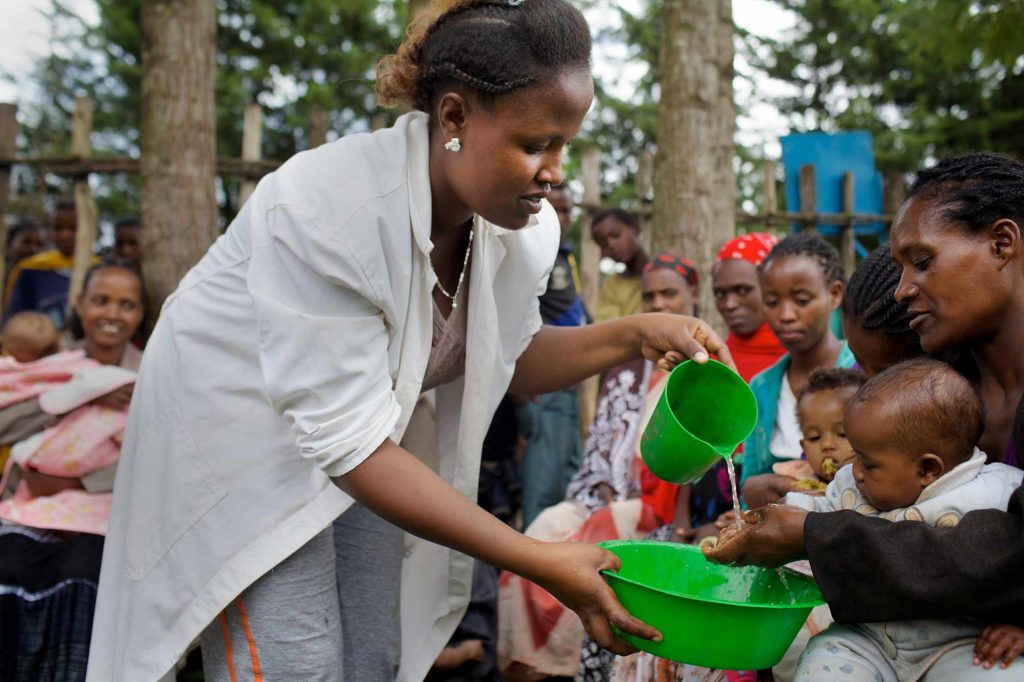
Hygiene Promotion
Water, Sanitation & Hygiene
Hygiene promotion is the systematic effort to encourage personal, domestic, environmental and food hygiene practices that prevent or mitigate the transmission of diseases.
Promoting safe hygiene practices is especially important in post-disaster settings, where people are more vulnerable to illness and death. In a camp setting, where large numbers live in highly congested, often unsanitary conditions, the spread of water-, sanitation- and hygiene-related diseases can occur easily. Without the consistent practice and promotion of personal and domestic hygiene, diarrheal and infectious diseases transmitted through a feco-oral route pose a significant risk to such populations. Simple handwashing with soap can reduce incidence of diarrheal disease by nearly half and of respiratory disease incidence by almost one-quarter—yet only one in every five people worldwide practices handwashing. For example, mothers who regularly wash their hands can reduce the risk of fatal infections in newborns—infections that contribute to approximately one-quarter of the nearly 3 million infant deaths that occur worldwide each year.
Hygiene promotion can be done through several means, ranging from face-to-face discussions, media campaigns and poster displays to the creation of community health and hygiene groups that share information and stories on hygiene promotion. After assessing key behaviors, motivators and barriers to adequate hygiene in communities, it is important to identify appropriate groups and communication channels/activities to promote hygiene effectively. Chosen methods should be field tested when possible.
To support and encourage personal hygiene, humanitarian organizations distribute hygiene kits at the household and individual levels, tailored to the local context. The hygiene kits contain most items required to practice adequate hygiene—including soap, menstrual hygiene supplies, materials for anal cleaning, water containers, and other culturally appropriate items that may be needed.
Our Response
Widely recognized as the most cost-effective intervention in the WASH sector, hygiene promotion is integrated into all of our WASH projects, to help the communities that we serve better protect themselves against waterborne diseases.
As part of our WASH programs, International Medical Corps routinely implements hygiene and sanitation promotion activities based on sector best practices. They are contextually appropriate, adequately monitored and have the goal of long-term behavior change. International Medical Corps’ hygiene promotion interventions include carefully considered message dissemination campaigns, focus group discussions, special activities or topic-specific awareness campaigns that accompany the distribution of items or complete kits containing items relevant to the messaging. We also promote hygiene awareness and handwashing messages as part of our nutrition programs and at the health facilities where we work. Examples of our hygiene promotion activities include the following.
YEMEN: Since war broke out in 2012, we have provided WASH services to more than 3 million Yemenis, supplying clean water to nearly 800,000 people through system rehabilitation and solar-powered pumps, improving sanitation for 1 million people and promoting good hygiene practices among another 1 million. We also work with communities to establish WASH infrastructure that can withstand extreme weather.
ETHIOPIA: International Medical Corps trains health workers and volunteers in hygiene and sanitation who have so far reached more than 130,000 refugees. Through campaigns and home visits, we raise awareness about handwashing, latrine use, water safety and waste disposal. In Bokolmayo camp, 90% of residents now understand the importance of handwashing, which has reduced illnesses and outbreaks of diseases such as cholera.
ZIMBABWE: In Zimbabwe, our efforts have contributed to increased knowledge and changes in rural communities’ behavior. We have worked to improve public health by promoting access to clean water and hygiene, reducing WASH-related diseases. We have established more than 300 community health clubs in Matabeleland North and South, teaching members proper hygiene practices and demonstrating how to build tippy taps and drying racks. Over the course of two years, our messaging has increased soap or ash use for handwashing, greatly reducing cases of diarrhea. So far, we have been able to prevent another outbreak of cholera.
GAZA: Our public awareness messages and sessions, targeting both patients and healthcare staff, have had a broad impact. These initiatives have improved overall hygiene practices by enhancing community resilience against waterborne diseases and by promoting proper infection prevention and control practices. Ultimately, these efforts have led to lifesaving outcomes at the community level, reinforcing the critical role that WASH services play in safeguarding public health and well-being.
International Medical Corps provided nearly 218,000 families with hygiene-related items, including family hygiene kits, in 2024.
In 2024, our WASH programs reached more than 2.8 million people with targeted hygiene-promotion awareness messaging, reinforcing safe hygiene behaviors in crisis-affected settings.
We provided more than 32,000 people with training as part of our WASH programs in 2024, including nearly 5,900 whom we trained in community mobilization and in health and hygiene promotion.